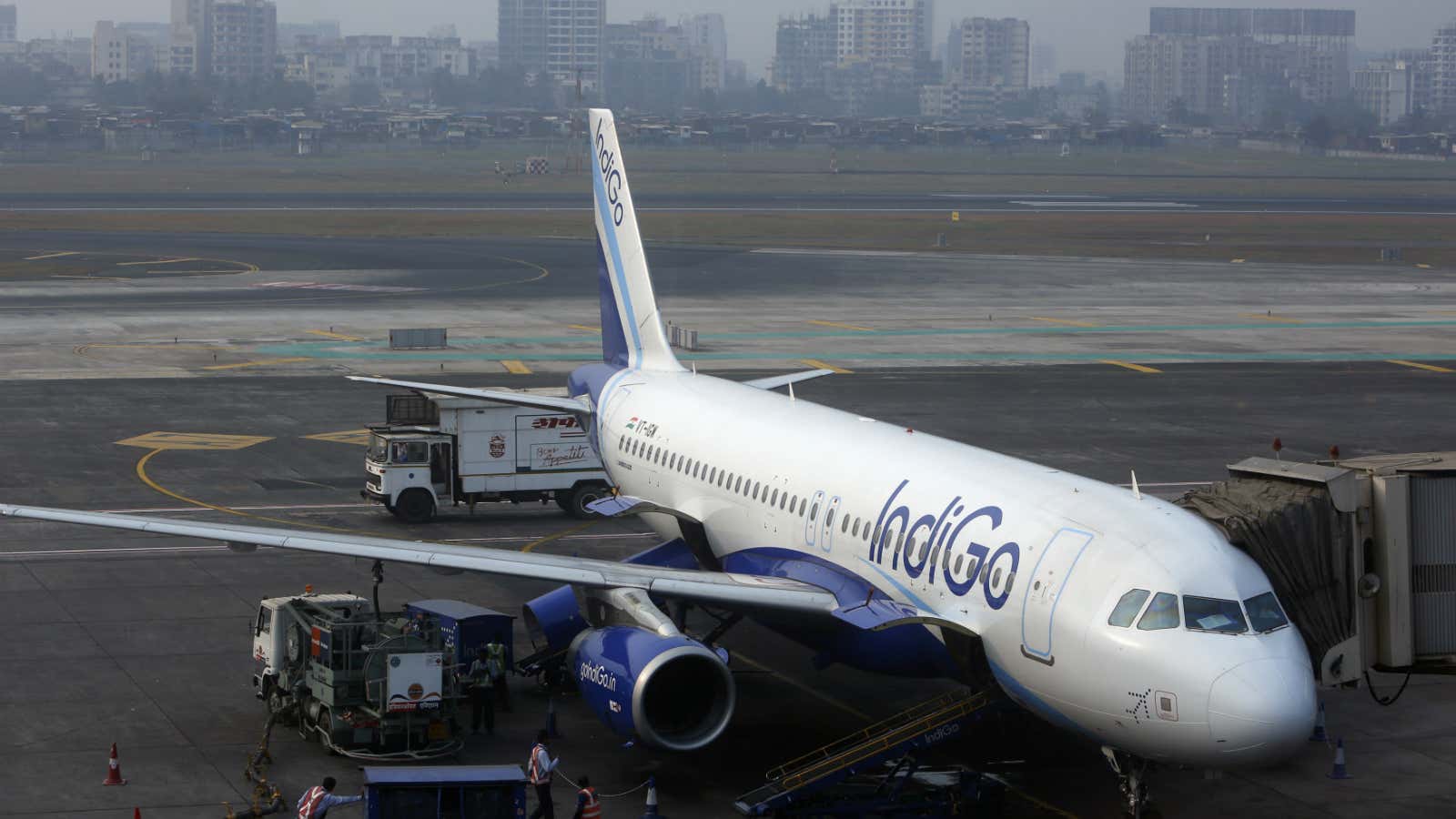On Feb. 10, after three reported instances of mid-air shut downs, IndiGo had to ground three of its Airbus aircraft flying on the Pratt & Whitney (P&W) engines. The grounding followed an order from the Indian aviation regulator, directorate general of civil aviation (DGCA).
European aircraft-maker Airbus has also put all future deliveries of the A320neo on hold, due to a safety warning raised by the European Aviation Safety Agency.
“The product safety boards of Pratt & Whitney and Airbus, post evaluating the PW1100G-JM engine issue, have decided that all neo deliveries are on hold till further notice,” IndiGo spokesperson Ajay Sahai Jasra said in an e-mail response to Quartz. “The issue impacts a limited sub-population of engines.”
The A320neo aircraft, which consumes between 15% and 20% less fuel than its predecessor, the A320ceo, was Airbus’s bet to race ahead of Boeing, its American rival. Airbus offers a choice between engines manufactured by two companies for its jetliner—P&W’s PurePower PW1100G-JM and CMF International’s LEAP-1A. CMF is a joint venture between US-based GE Aviation and French firm Safran Aircraft Engines.
In all, Indigo, India’s largest airline, has ordered 530 units of the new aircraft since 2011. And this is not the first time it has hit an air pocket since the plane-maker first delivered its new A320neo in 2016.
Two years of teething troubles
Things were rocky from the start. Due to some cooling issues with the P&W engines, Airbus delayed the first batch of deliveries to IndiGo by nearly four months. The airline finally received 26 planes in March 2016.
However, the engines continued to face durability issues. In September 2016, amid snags and delivery lags, the American engine-maker’s parent firm, United Technologies, cut its production target.
In February 2017, India’s DGCA ordered IndiGo and GoAir to inspect the engines after completing 1,000 hours of flying. The airlines were asked to carry out repeat checks every 500 hours. To circumvent engine troubles, they had to fly at lower altitudes, increasing their fuel expense.
A month later, the regulator began probing the issue again after two GoAir flights were grounded due to engine trouble.
In July, IndiGo had to ground at least nine planes due to issues with the P&W engines. Following this, the airline considered opting for the GE engine-installed A320neo instead. By late 2017, the total orders for P&W’s engines had fallen to one-tenth those of LEAP-1A, the other category of engines on Airbus aircraft. Eventually, to make for the delay in the A320neo deliveries, IndiGo temporarily wet leased planes from Lithuanian airline Small Planet in December. Wet-leasing involves an airline renting planes along with their crew.
Meanwhile, the delivery delays took a toll on Airbus’s operating profits in July 2017.
The year 2018 brought a new issue to light with Pratt & Whitney engines. This time, it involved its “knife edge seal”—a seal in the engine’s high-pressure compressor. The problem has affected nearly a third of the operating A320neo planes across 18 airlines, globally, Airbus said in an e-mail response. This includes around 14 GoAir and IndiGo aircraft.
“The issue…has been identified on a limited number of recently-delivered P&W GTF (geared turbofan powered) engines,” Airbus said. “Of the 113 aircraft, some 10% have both engines affected. This means a minimum of one engine needs to be changed on these aircraft…Customers have been informed and P&W and we are in contact with the airlines to minimise any disruption.”
Bane of disruptive technology
While complications are expected in newer technologies, especially since the utilisation rate of these engines is fairly high, Indian conditions have made matters worse, Mark Martin, chief executive officer of aviation consulting firm Martin Consulting said.
“We are dealing with an extremely tough environment for an engine (in India)…we are also flying these engines more, for about 14-15 hours a day,” Martin said. “Because of its design, it’s not adapting to the market environment.”
Airbus’s rival Boeing, too, faced rough weather in its day. The company’s the twin-engine jetliner, Boeing 787, was grounded in 2013. The issues plaguing “the dreamliner,” as the aircraft was named, included fuel leaks and battery fires.
So, according to Martin, grounding the affected aircraft and resolving the issue is the best course of action, even though the revenues of airlines like IndiGo may take a hit. “Instead of there being stop-gap arrangements with quick-fix solutions, it’s better that we ground the entire fleet and fix the problem for good,” he said. “It’s (the issue) not going to disrupt the deal (between Airbus and IndiGo).”
Meanwhile, IndiGo will continue to add Airbus’s older aircraft, A320ceo, and Franco-Italian firm ATR’s planes to its fleet, Jasra said. But two years and over 100 aircraft later, patience for Pratt &Whitney’s engine issues is wearing thin.
